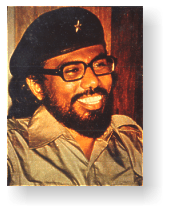 Rohan Gunaratna has provided the following thread to Rajani Thiranagama, in his description of ‘Vikalpa kandayama,’ one of the six JVP radical splinter groups.
Rohan Gunaratna has provided the following thread to Rajani Thiranagama, in his description of ‘Vikalpa kandayama,’ one of the six JVP radical splinter groups.SANGAM.ORG
Ilankai Tamil Sangam, USA, Inc.
Association of Tamils of Sri Lanka in the USA
by Sachi Sri Kantha
|
First, the links of UTHR (Jaffna) to the JVP and its radical splinter group has thus been established, from two independent Sinhalese sources, who are also no LTTE sympathizers. Last January, even Susantha Goonetilleka (a virulent anti-Tamil polemicist), whose wife was the then chief organizer of UTHR activity, had corroborated this link. |
Following the appearance of my essay entitled, ‘Three Mules and Sister Rajani’ recently, I read a criticism by a correspondent that I had relied solely on the words of Kumar Rupesinghe (as presented by him in January 2006) to infer the indirect link of the so-called University Teachers for Human Rights (UTHR) to the JVP. Since this is a valid criticism, the onus was on me to provide another independent source to vindicate my view. I felt that it would be more credible, if this second source is an anti-LTTE partisan as well. I report here that I have found this second source. And it is Rohan Gunaratna, the now widely-touted “terrorism expert.” I have previously even tagged Rohan Gunaratna, as the ‘Temple Drum [Kovil Melam] of Terrorism Industry.’
Before he entered the international circuit sixteen years ago, Rohan Gunaratna published a political history of the JVP. The book’s title was ‘Sri Lanka A Lost Revolution: The Inside Story of the JVP’ (Institute of Fundamental Studies, Kandy, 1990, 366pp). In the Author’s Note, Gunaratna has written, “[this] is the story of the struggle of the Janatha Vimukthi Peramuna (JVP), a politico-military group, to change the country’s social and political system. The JVP revolted against three elected Governments within a span of 18 years.” For the details assembled [since the author of this book had feeds from the Sri Lankan state’s Intelligence arm] and because of the ethno-cultural proximity Gunaratna had with the protagonists of JVP, I’d grade this book as a good contribution to the island’s political literature. Here are two excerpts from this book, which link the UTHR and Rajani Thiranagama to the JVP and its offshoots.
Excerpt 1:
“The JVP cover organisations included the National Students Centre (Jathika Shishya Maddiyasthanaya), the National Workers Action Centre (Jathika Kamkaru Satan Maddyasthanaya), the Patriotic Peoples Armed Troops (Deshapremi Janatha Sannadhda Balakaya) and the Patriotic Peoples Movement (Deshapremi Janatha Viyaparaya). Sympathetic organisations of the JVP included the Citizen’s Committee of Colombo, Human Rights Organisations of University Teachers headed by a prominent lady lecturer, Inter University Bhikku Federation headed by a prominent bhikku from the University of Sri Jayawardhanapura, Inter University Students Federation, Medical Students Union, Socialist Students Union and the Law Students Union…” (p.45)
As I have indicated in my previous essay, in his vituperative exchange, Kumar Rupesinghe had identified this “prominent lady lecturer” of UTHR as Hema Goonetilleka, the wife of Susantha Goonetilleka; and Susantha Goonetilleka has not refuted this identification.
Excerpt 2:
 Rohan Gunaratna has provided the following thread to Rajani Thiranagama, in his description of ‘Vikalpa kandayama,’ one of the six JVP radical splinter groups.
Rohan Gunaratna has provided the following thread to Rajani Thiranagama, in his description of ‘Vikalpa kandayama,’ one of the six JVP radical splinter groups.
“Vikalpa kandayama: The ‘Alernative Group’ was another significant clique which attracted many revolutionaries from the JVP. This movement, also known as the group of Twenty Three, is committed to revolutionary progressive leftist ideals. Thomas George, a member of the group was a contemporary of Wijeweera, when the JVP leader was a member of the Communist Party (Peking). Dayapala Tiranagama is another. (His Tamil wife Rajani was killed in Jaffna in 1989). He was a member of the Communist Party who joined the JVP, but left the movement in 1968 after a discourse by Wijeweera on the JVP policy towards the Indian plantation workers. This group was also enriched by several other members who were combatants of the 1971 JVP uprising…” (p.131).
Even in the sentence which states Rajani’s assassination in 1989, Rohan Gunaratna did not mention the LTTE as her assassins. This is somewhat not insignificant, since Gunaratna has been a guy who would tag all the horrors in the world to the LTTE’s deeds at the drop of a hat!
Inference
I can make two inferences. First, the links of UTHR (Jaffna) to the JVP and its radical splinter group has thus been established, from two independent Sinhalese sources, who are also no LTTE sympathizers. Last January, even Susantha Goonetilleka (a virulent anti-Tamil polemicist), whose wife was the then chief organizer of UTHR activity, had corroborated this link. Secondly, by failing to confess about this deceitful UTHR-JVP link for the past 16 years, Rajan Hoole and his coterie have repeatedly attempted to hoodwink the Eelam Tamil public.
© 1996-2025 Ilankai Tamil Sangam, USA, Inc.